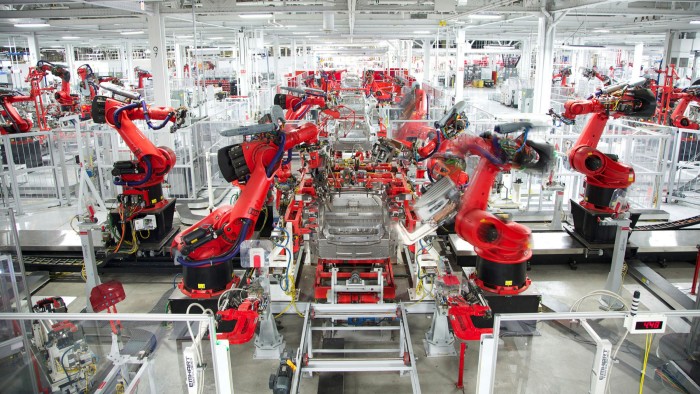Stand ready for the big five technology convulsions reshaping markets

Roula Khalaf, Editor of the FT, selects her favourite stories in this weekly newsletter.
The writer is founder and chief executive of Ark Investment Management
The global economy appears to have entered a period of convulsive changes, some exceptionally good and others devastating, that could shape financial markets for years to come.
In Ark’s view, any company not investing aggressively in one or more of five major platforms of innovation will lose its way. In harm’s way are companies that have engineered their financial results to satisfy the short-term demands of short-sighted investors.
Those that have leveraged their balance sheets to buy back shares and pay dividends are at particular risk as they will have less balance sheet flexibility to invest in response to the technological shift.
Seeded during the tech and telecom bubble more than 20 years ago, the five main platforms of innovation that we think will transform the global economy are: DNA sequencing, robotics, energy storage, artificial intelligence, and blockchain technology. These involve 14 technologies including gene therapies, 3D printing, cloud computing, big data analytics, and cryptocurrencies.
Importantly, they cut across economic sectors, posing problems for research efforts that are short term, siloed, and highly specialised. In our experience, most research departments of banks and fund managers are structured in that way, creating inefficiencies to be exploited as “convergences” create the new world order.
We think sectors most at risk of disintermediation are energy, industrials, consumer discretionary, communications services, healthcare, and financial services.
As autonomous transport evolves, for example, autos, rails, and airlines are likely to capitulate to the convergence of robotics, energy storage, and artificial intelligence. Combined, these forces will collapse the cost structure of transport. Traditional healthcare is also likely to give way to the convergence of next generation DNA sequencing, artificial intelligence, and gene therapies.
Meanwhile, in traditional financial services, the middlemen that dominate today’s financial ecosystem face disintermediation thanks to application programming interfaces (APIs), social platforms and blockchain technology that will enable the convergence of business and consumer marketplaces.
The convulsions will throw company forecasts for a loop, particularly in the developed world, which is saddled with mature infrastructure.
Broadly defined, the sectors at risk of disintermediation account for more than half of the S&P 500. Though at small bases today, we believe most innovation platforms are entering dramatic growth trajectories thanks to lower costs and higher productivity.
For example, we forecast that in response to the 28 per cent cost decline in lithium-ion batteries for every cumulative doubling in units produced globally, prices will continue to fall, “turbocharging” electric vehicle sales.
According to our estimates, EV sales will increase 20-fold globally during the next five years, from an estimated 2m and about 2.5 per cent of the market this year to 40m and about 45 per cent in 2025. Even if you think this ambitious, the direction of travel appears clear. It is one reason why Ark is a shareholder in Tesla.
The bad news is that the more expensive petrol-powered cars that dominate the market today will lose almost half of their sales base. Moreover, if transport goes autonomous, as we believe it will, the auto market will continue to shrink as the capacity utilisation per car increases.
More broadly, if our forecasts for the five innovation platform are near the mark, there will be an economic impact. Both growth in the value of goods and inflation are likely to surprise on the low side of expectations as market share shifts to the poorly measured digital world and as the “good” deflation associated with technology takes hold.
We believe the winners will win in a big way but losers, particularly those that have levered balance sheets to satisfy certain stakeholders, will unwind. While risk-free interest rates are likely to remain low, spreads between companies on debt costs could widen dramatically as disruptive innovation — the likes of which we have not seen since the telephone, electricity, and the automobile burst on the scene in the Roaring Twenties — causes dislocation.
So, investors beware. Innovation appears to be evolving at such a rapid pace that traditional equity benchmarks are being populated increasingly by so-called value traps — stocks that are “cheap” for a reason. Critical to investment success will be moving to the right side of change.
Letter in response to this article:
Is the Roaring Twenties the most apt analogy? / From Daniel Mauro, Chief Investment Officer, Army Capital, Chicago, IL, US
Comments